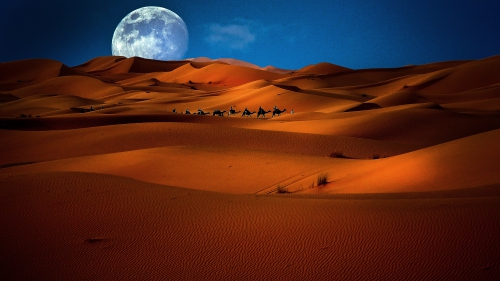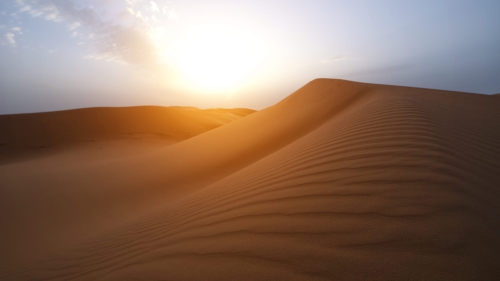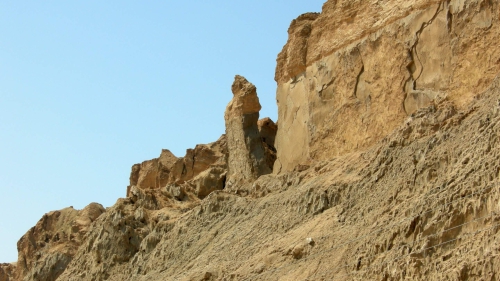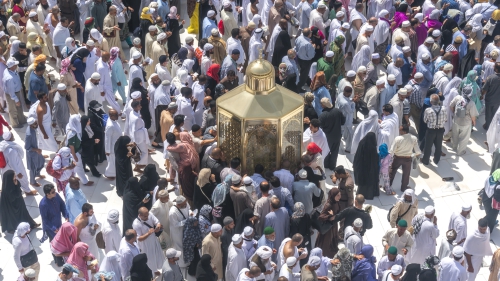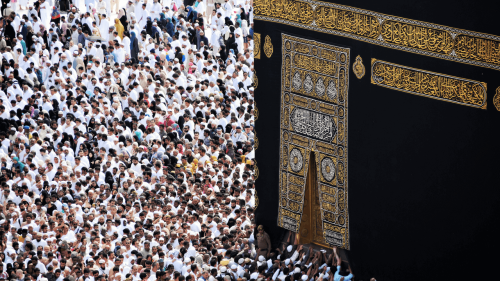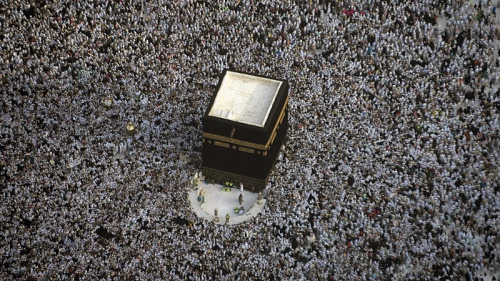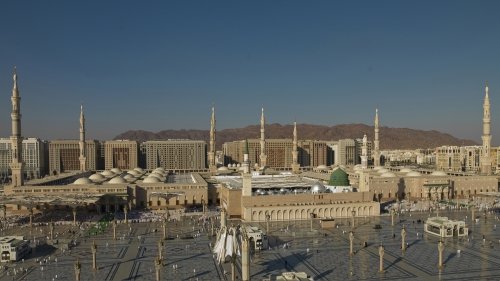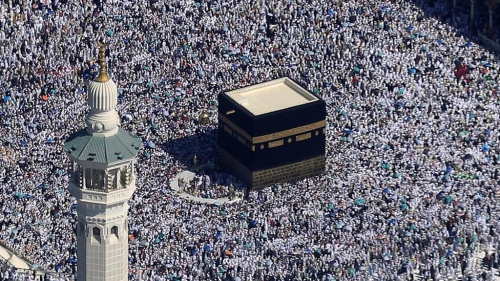Prophet Abraham’s Hajj for Muslims and Jews

Saudi Arabia is increasing this year’s Hajj capacity to 1 million Muslim pilgrims, with all the necessary health measures to be taken for everyone’s safety. In previous centuries no one ever thought that a million Muslim could partake in an annual Hajj.
Prophet Abraham established several sacred sites in the Land of Israel according to the Torah book of Genesis (12:7, 13:4, 13:18, 21:33); but Prophet Abraham’s most famous site was the ancient one that he and his son Prophet Ishmael rebuilt in Makka.
Since Makka is over 700 miles south of the Land of Israel, Prophets Abraham and Ishmael must have arrived in Makka through Divine guidance; and Islamic tradition clearly states that Prophets Abraham and Ishmael were guided to Makka by the sakina (Hebrew Shekinah).
The Sakina/Shekinah is mentioned in the Quran which states, “And their Prophet [Samuel] said to them [the Children of Israel]: “A Sign of his [Saul/Talut] authority is that there shall come to you the Ark (Tabut), and in it Sakina (a Covenant) with security from your Lord, and the relics left by the family of Moses and the family of Aaron, carried by angels. In this is a symbol for you if you indeed have faith”. (2:248)
In Islamic thought, Sakina/Shekinah refers to the tranquility, serenity and peace of mind that results when a believer becomes totally aware of God's near by presence. Although Sakinah dwells in the heart of one who is already a sensitive and faithful believer; Sakina/Shekinah now comes to him or her directly from God's close presence and personal interest; to confirm and strengthen that believer's faith.
As the Qur'an says “It is God who sent down Sakinah (tranquillity) into the hearts of the believers, that they would increase in faith along with their (present) faith.” (48:4) Thus, the experience of Sakinah/Shekinah is both God's gift of enhanced, confirming faith, and the product of one's own faithfulness. (Qur'an 9:26 & 40) Both of these two experiences are frequently found during Hajj.
Modern Jews can see in the annual Muslim Hajj, some of the wonderful spiritual uplift that occurs when large numbers of people from all over the world travel to one holy place and join together in a traditional religious ceremony. Muslims in turn, can see some similarities in the ancient Jewish practice of Hajj ceremonies.
Very few Jews realize that for more than 1,000 years, while Jerusalem's First and Second Temple--Bait ul Muqaddas/Beit HaMiqdash stood, the Jewish festival of Hag Sukkot was celebrated as a Hajj, a pilgrimage festival. In Biblical times the Hebrew letter "g" was sometimes pronounced "g" as in gym so Hag was pronounced Hajj.
In the centuries after the Jerusalem Temple was destroyed by the Romans; pilgrimage ceased. Today the overwhelming majority of Jews outside the Land of Israel live in Protestant countries where pilgrimage plays little or no role in religious life. Thus, it is very hard for most Jews to feel the tremendous spiritual uplift that can occur to pilgrims on the long path to, and amidst the mass tumult of, a uniquely holy and sacred place.
The Torah declares, “Celebrate Hajj Sukkot for seven days after you have harvested the produce of your threshing floor and your winepress. Be joyful at your festival—you, your sons and daughters, your male and female servants, the Levites, the foreigners, the fatherless and the widows who live in your towns.
For seven days celebrate the festival to the Lord your God at the place the Lord will choose. For the Lord your God will bless you in all your harvest and in all the work of your hands, and your joy will be complete. Three times a year all your men must appear before the Lord your God at the place He will choose: at the Hajj of Matzah, the Hajj of Weeks, and the Hajj of Sukkot. (Deuteronomy 16:13-16)
On each of the first six days of Hajj Sukkot it was traditional to circle the Temple alter while reciting psalms from the Zabur of Prophet David. On the seventh day of Hajj Sukkot the custom was to circle the Temple alter seven times. As the Oral Torah says: "It was customary to make one procession around the altar on each day of Hajj Sukkot, and seven on the seventh day." (Mishnah Sukkah 4:5). Each circle is done in honor of a prophet; Abraham, Isaac, Jacob, Joseph, Moses, Aaron and David.
Muslims will see some similarities and some differences between the Jewish Hajj and the Islamic Hajj.
With the destruction of the Second Temple by the Romans in 70 CE, the pilgrimage aspect of the week long harvest festival began a gradual decline in the spiritual consciousness of the Jewish People. Most of the many thousands of Jews from foreign lands outside the Land of Israel; and the tens of thousands of Jews from all over the Land of Israel outside the city of Jerusalem; who used to came each year to celebrate the week of Sukkot in Jerusalem at Bait ul-Muqaddas, the furthest sanctuary; ceased coming.
Two generations later, after a second major Jewish revolt (132-135 CE) in the land of Israel, the Romans rebuilt Jerusalem as a pagan city filled with idols, that stopped all Jews from coming to the ruined site of the Jerusalem Temple--Bait ul Muqaddas/Beit HaMiqdash.
But even centuries after the destruction of the Jerusalem Temple, and the end of pilgrimage, generations of Jews repeated wonderful tales about pilgrimage experiences in Jerusalem and at the Holy Temple.
“Crowded as Jerusalem was, there always was enough room to squeeze everyone in. Indeed, every year it seemed a continuing miracle that pregnant woman didn't suffer a miscarriage, rain showers never quenched the fire on the alter, winds never blew smoke from the fire into the crowds of worshipers, and no one was ever bitten by a scorpion or a snake. Most amazing of all, no one complained, ‘It is difficult for me to find lodging in Jerusalem'.” (Pirkay Avot 5:8)
For Muslims, the Furthest Sanctuary is located in Jerusalem. “Glory to He Who carried His servant by night, from the Holy Sanctuary to the Furthest Sanctuary, the precincts of which We have blessed. so that We might show him some of Our signs. Surely He is the All-Hearing, the All-Seeing. (Qur'an 17:1) It is significant that the ruins of the Jerusalem Temple was the site of Prophet Muhammad's ascension—miraj-- up to the heavens.
The Ka'ba rebuilt by Prophet Abraham and Prophet Ishmael, was some centuries later polluted by the introduction of many idols. Some centuries later Prophet Solomon built a Temple on the site where Prophet Abraham Prophet Isaac were tested by God.
Some centuries later the Temple of Prophet Solomon was destroyed by the Babylonians. It was then rebuilt only to again be destroyed some centuries later by the Romans, who would later pollute the whole site with a Roman city with buildings and streets filled with idols.
The destruction of the Furthest Sanctuary center of monotheistic pilgrimage in Jerusalem by the pagan Romans, was five and a half centuries afterward overcome by Prophet Muhammad's ascension—miraj up to the heavens; and then the removal by Prophet Muhammad of all the idols from the long paganized Ka'ba (Holy Sanctuary) in Makka.
The Jerusalem Temple will not be rebuilt by human hands, but Christians and Jews in large numbers still make a pilgrimage to Jerusalem similar to the Muslim Umrah.
To this very day, Jerusalem and Mecca remain much smaller than the capitals of the great empires of the distant past, like Rome and Constantinople, and the recent past, like London and France. Yet the spirit that continues to rush forth from those two geographically tiny places provides inspiration to billions of Christians, Jews, and Muslims throughout the world.
The Prophet Zechariah envisions a future time when God helps humans to establish worldwide peace. Then all the nations in the world then may travel in peace to Makka or Jerusalem to worship the one ad only God.
During Hajj Sukkot, a future Jerusalem will welcome both Jews and non-Jews, even including those who were previously Israel's enemies: “Then the survivors from all the nations that have attacked Jerusalem, will go up year after year to worship the King, the Lord Almighty, and to celebrate Hajj Sukkot.” (Zechariah 14:16)
Just as the Ka'ba has always welcomed all Muslims who answer Prophet Abraham’s call: “Call upon the people for Hajj. They will come to you on their bare feet, or riding any weak camel, and they come to you from every far desert. (Qur'an 22:27).
Topics: Hajj, Interfaith, Jerusalem, Jews, Makkah (Mecca), Masjid Al Aqsa, Prophet Ibrahim (Abraham)
Views: 2958
Related Suggestions






